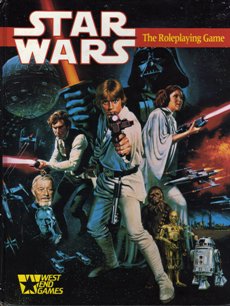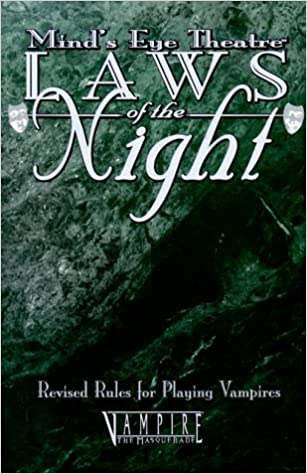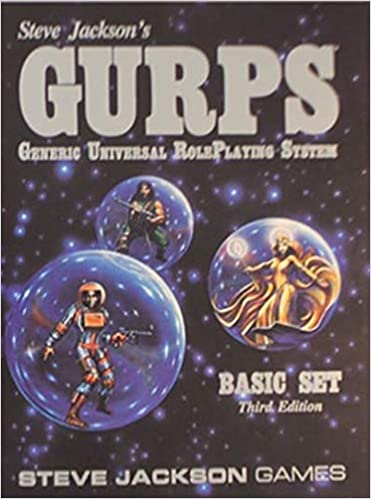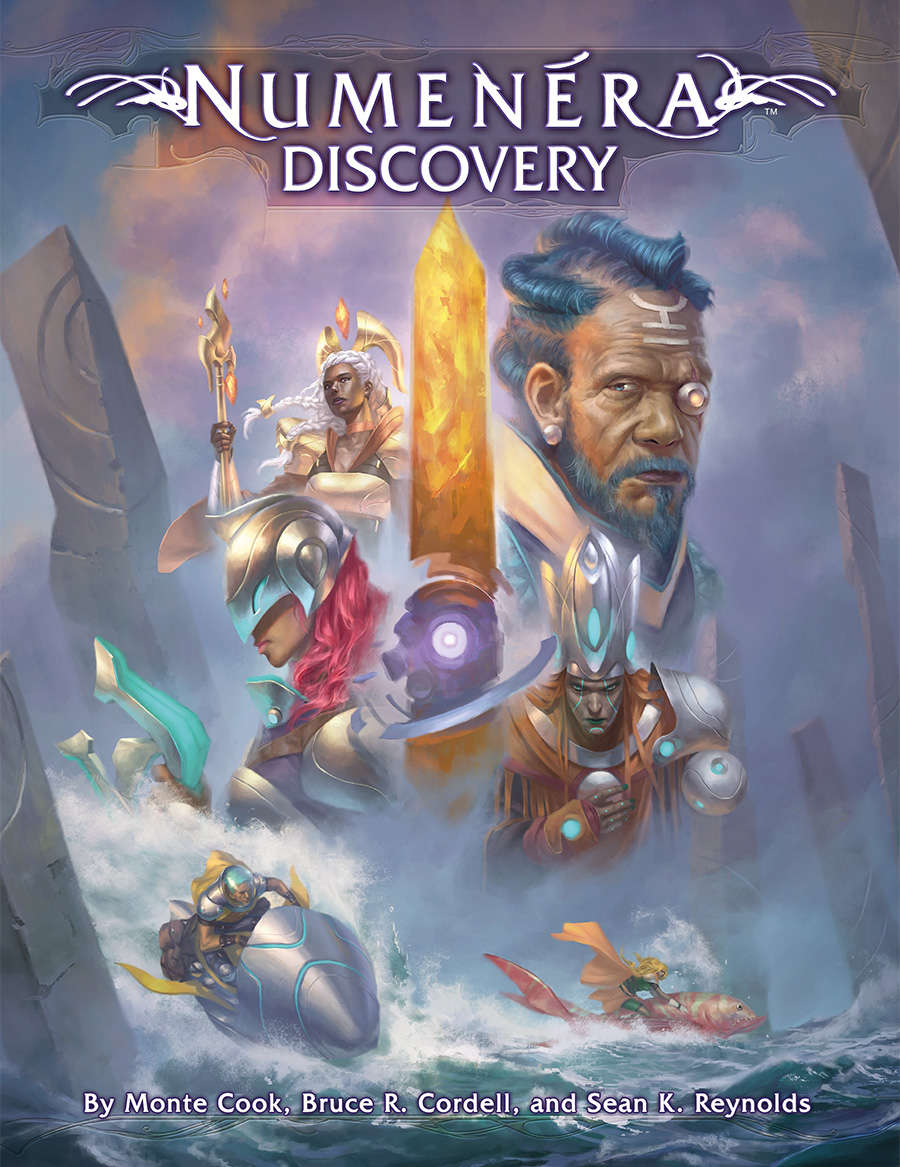During the pandemic I’ve seen more and more memes of lists some with commentary and some without. Recently, one of my friends posted 10 RPGs that had influenced them. So last time, I began by posting four of my ten “most influential RPGs.” Today, we’ll wrap up with the final six which is a lot harder than those first four. Most of those were super obvious, “must-lists.” Today we’re digging a little deeper.
 Star Wars (1987 / d6): I have been a lifelong fan of Star Wars. For all their flaws, I enjoy all three trilogies of the Skywalker Saga and the other new movies. I read a lot of the EU novels and I’ve watched eagerly what I’ve had time to from the new TV offerings. So, it should come as no surprise that when I discovered West End Games’ Star Wars RPG in 1987 I leapt on it. The early Star Wars RPG taught me things about narrative play I hadn’t expected: Cut scenes, starting the sessions in media res, and adventure scripts. The last of those I didn’t really appreciate until much later and lately I’ve been toying with experimenting with this tool again. We had some success with the script tool while revisiting one my favorite adventures from the d6 era last year. We began the session by paraphrasing the accompanying script and it got everyone in character and playing without a lot of GM exposition. I can see this being super useful for convention play and one shot adventures.
Star Wars (1987 / d6): I have been a lifelong fan of Star Wars. For all their flaws, I enjoy all three trilogies of the Skywalker Saga and the other new movies. I read a lot of the EU novels and I’ve watched eagerly what I’ve had time to from the new TV offerings. So, it should come as no surprise that when I discovered West End Games’ Star Wars RPG in 1987 I leapt on it. The early Star Wars RPG taught me things about narrative play I hadn’t expected: Cut scenes, starting the sessions in media res, and adventure scripts. The last of those I didn’t really appreciate until much later and lately I’ve been toying with experimenting with this tool again. We had some success with the script tool while revisiting one my favorite adventures from the d6 era last year. We began the session by paraphrasing the accompanying script and it got everyone in character and playing without a lot of GM exposition. I can see this being super useful for convention play and one shot adventures.
 Laws of the Night (Wild etc.): Originally released as Mind’s Eye Theater: The Masquerade and The Apocalypse, I played these game for a very long time. Some of my best and most of my worst roleplaying experiences occurred while playing these games.
Laws of the Night (Wild etc.): Originally released as Mind’s Eye Theater: The Masquerade and The Apocalypse, I played these game for a very long time. Some of my best and most of my worst roleplaying experiences occurred while playing these games.
I enjoy the classic World of Darkness as a setting (especially tabletop Werewolf) but I have something of a love-hate relationship with the LARP rules and the culture of play where the back-biting politics makes its way into real world relationships. Of all the lessons I’ve learned from gaming some of the most useful real-world lessons have come from the in- and out-of-game politics centered around vampire society.
My biggest problems with the system, stems from the fact that the rules were designed with shorter and more intimate games in mind. Often intended to be played as a special session as a part of a longer running tabletop campaign or as a short story within the World of Darkness. In larger-long running LARPs with fifty or more players the system mechanics become overtaxed. Neonate vampires gain the potency of elder Kindred in just a couple of years of weekly play and when a character kicks around for nearly a decade they are huge and start to run out of things to spend XP on. While in genre at 10 years they’re still babies compared to their hundreds or thousands of years old superiors.
While a game can accommodate certain styles of play doesn’t mean it’s at its best in those cases. This is not to say players who enjoy large organized play LARPs like I used to be a part of are doing it wrong. It’s just not for me anymore. I’d certainly consider playing in a LARP again if it was small, intimate, and limited in scope.
 GURPS: While I think Palladium’s rules may have been the first multi-genre game system I had experience with our group pretty much stayed solidly locked on superheroes or Robotech and every genre required a whole new rulebook. With GURPS I was introduced to the actual infinite possibilities of the hobby all in one book. My battered copy of the rules supported dungeon crawls, super heroes, time-travelers, historical settings, far future and weirder combinations on occasion.
GURPS: While I think Palladium’s rules may have been the first multi-genre game system I had experience with our group pretty much stayed solidly locked on superheroes or Robotech and every genre required a whole new rulebook. With GURPS I was introduced to the actual infinite possibilities of the hobby all in one book. My battered copy of the rules supported dungeon crawls, super heroes, time-travelers, historical settings, far future and weirder combinations on occasion.
Most compelling was the ability to make exactly the character you wanted to play. I’m pretty sure GURPS cemented my ongoing love of generic rules systems. It was also the first game where I replaced my rulebook because I wore out the original.
Another strength of the GURPS line has always been the sourcebooks. I’m not actively playing GURPS but I still tap one or more setting guides to add depth and details to whatever campaign I may be running.
 Cyberpunk: 2013 may be history now but when I first discovered cyberpunk it felt impossibly far in the future and the 2020 of Cyberpunk’s next edition even more removed. So here we are midway through real 2020 and I want to know where are is all the marvelous tech to go with our current dystopic conditions? Cyberpunk came at the exact right time in my life. A violent post-modern-punk-rebellion with an ethos of look badass kicking ass was just what we needed to get out of the dungeon.
Cyberpunk: 2013 may be history now but when I first discovered cyberpunk it felt impossibly far in the future and the 2020 of Cyberpunk’s next edition even more removed. So here we are midway through real 2020 and I want to know where are is all the marvelous tech to go with our current dystopic conditions? Cyberpunk came at the exact right time in my life. A violent post-modern-punk-rebellion with an ethos of look badass kicking ass was just what we needed to get out of the dungeon.
One of my favorite aspects of the Cyberpunk books is large portions of the texts were written in the vernacular of the setting, the effect immerses the reader in the setting. Some of the best examples included the gear sourcebooks called Chromebooks (not the Google kind) and the Corporate Sourcebooks. The Chromebooks read like digital catalogs selling your PC on the latest styles in armored clothes and hottest new firearms. While the Corporation sourcebooks read almost like annual reports rather than RPG supplements. The sense of a believable lived in world has shaped how I’ve written content for my own homebrew settings as well as at least one professional product.
 FATE: Whether you know it as FATE or Fudge, this game features a flexible narrative ruleset suitable for nearly any setting. When I first encountered the Fudge ruleset it was sold as a tool kit to create your own RPG. The next time I encountered the rules it was in Evil Hat’s Spirit of the Century then later in FATE Core and FATE Accelerated. The designer’s at Evil Hat really polished the rough edges off Fudge and codified the assorted pieces into a coherent game system still every bit as flexible as the original.
FATE: Whether you know it as FATE or Fudge, this game features a flexible narrative ruleset suitable for nearly any setting. When I first encountered the Fudge ruleset it was sold as a tool kit to create your own RPG. The next time I encountered the rules it was in Evil Hat’s Spirit of the Century then later in FATE Core and FATE Accelerated. The designer’s at Evil Hat really polished the rough edges off Fudge and codified the assorted pieces into a coherent game system still every bit as flexible as the original.
Improvisational play is a key aspect of FATE’s design. Players and GM alike are empowered to shape the narrative not just through the actions of the characters but also through setting details of the environment the characters can interact with.
 Numenera (Cypher System): Numenera and the Cypher System are my current favorite setting and rules system combination. The Cypher System utilizes unique resource management mechanics that empowers players to choose how they may effect dice outcomes while the GM is empowered to intrude on the players with story complications for XP rather than depend on the randomness of dice.
Numenera (Cypher System): Numenera and the Cypher System are my current favorite setting and rules system combination. The Cypher System utilizes unique resource management mechanics that empowers players to choose how they may effect dice outcomes while the GM is empowered to intrude on the players with story complications for XP rather than depend on the randomness of dice.
The Ninth World, the default setting of Numenera is a weird techno-fantasy world of ancient ruins to explore, strange and hideous creatures to face, and wondrous relics to discover. It satisfies many of my favorite aspects of Gamma World and traditional fantasy RPGs like D&D and Pathfinder.
Now this list is far from exhaustive. Nearly every game I’ve played has had an influence on my personal style and gaming preferences. Some omissions were hard to lose but ultimately I think I got the list right.






